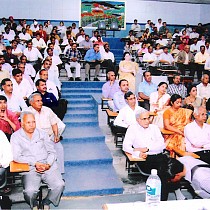BIOEFFICACY OF SOME NEWER INSECTICIDES AND BIO-PESTICIDES AGAINST BARLEY APHID, RHOPALOSIPHUM MAIDIS (FITCH)
Department of Entomology, S.K.N. College of Agriculture, Jobner, Rajasthan
HABBAL SINGH AND B.L. JAT
In a study on bioefficacy of some newer insecticides and bio–pesticides against the barley aphid, imidacloiprid
(0.005%) proved most effective followed by dimethoate (0.03%) and thiamethoxam (0.025%) in reducing the aphid
population. Metarhizium anisopliae (2×107 spores l–1) was least effective followed by azadirachtin (5 ml l–1) and NKSE (10%). Maximum seed yield of 42.81 q hal–1 was obtained from the plots treated with imidacloprid followed by dimethoate (42.58 q ha–1) and thiamethoxam (42.21 q ha–1) and minimum was in the plots treated with M. anisopliae (36.42 q ha–1). However, highest benefit cost ratio (10.14) was recorded in the treatment of dimethaote followed by imidacloprid (7.16) and endosulfan (6.50).


